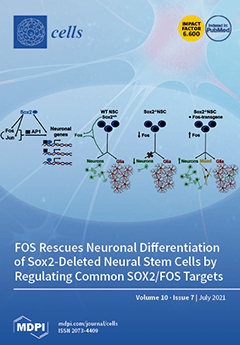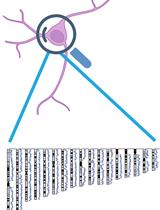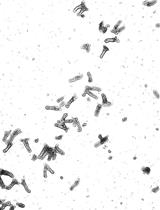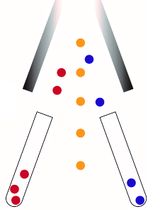- EN - English
- CN - 中文
A Mouse Infection Model with a Wildtype Salmonella enterica Serovar Typhimurium Strain for the Analysis of Inflammatory Innate Immune Cells
用于分析炎性先天免疫细胞的野生型肠沙门氏菌鼠伤寒血清型小鼠感染模型
发布: 2022年04月05日第12卷第7期 DOI: 10.21769/BioProtoc.4378 浏览次数: 2504
评审: Juan Facundo Rodriguez AyalaSaskia F. ErttmannLokesh Kalekar
Abstract
Salmonella enterica serovar Typhimurium (S. Typhimurium) is a Gram-negative, facultative intracellular bacterium, which causes gastrointestinal disorders in humans, and systemic, typhoid fever-like infections in mice. Our current knowledge regarding the involvement of cellular and humoral immunity in the defense from S. Typhimurium infections is largely based on animal models with attenuated strains. Cells of the innate immune system act as one of the first barriers in the defense from bacteria. We established a robust experimental model for the characterization of these cell types and their response during host-pathogen interactions. Therefore, this protocol focuses on the characterization of macrophages, monocytes, and neutrophils in the spleens of infected animals by employing multi-color flow cytometry.
Keywords: Macrophages (巨噬细胞)Background
Salmonella enterica is a highly iron-dependent siderophilic intracellular Gram-negative pathogen, which can cause local intestinal disease, or severe systemic infection and septicemia. Hence, it was included in the WHO list of the most serious infectious disease threats to human health (Keestra-Gounder et al., 2015; Bumann and Schothorst, 2017). Salmonella invades and multiplies within mononuclear phagocytic cells in the liver, spleen, lymph nodes, and Peyer’s patches, in so-called Salmonella-containing vacuoles (SCV) (Steele-Mortimer, 2008). However, Salmonella exhibits different mechanisms to evade antimicrobial activities, for example by inhibiting phagolysosomal fusion (Baumler and Fang, 2013; Bhutta et al., 2018).
Several immune cells are important in the defense against bacterial infections. While some act as the first barrier, by taking up and killing bacteria, others are responsible for long-term immunity or for coordinating efficient anti-microbial immune responses. Macrophages, dendritic cells (DCs), and neutrophils represent one of the first lines of defense against invading pathogens like Salmonella, by recognizing specific pathogen-associated molecular patterns (PAMPs), and danger-associated-molecular patterns (DAMPs) (de Jong et al., 2012). Recognition of Gram-negative bacteria in macrophages involves the binding of LPS to a receptor complex, leading to the secretion of pro- and anti-inflammatory cytokines (Nagai et al., 2002; Bode et al., 2012). Macrophages can polarize dependending on local factors within the microenvironment, microbial stimuli, and cytokines secreted by other cells. Pro-inflammatory macrophages are essential components of anti-microbial host defense mechanisms, and can be characterized by the synthesis of inducible nitric oxide synthase (iNOS). Anti-inflammatory macrophages dampen the inflammatory state, by producing anti-inflammatory cytokines and Arginase-1 (ARG1). ARG1 cleaves L-arginine, the substrate of iNOS, and thereby impairs the control of various intracellular pathogens (Mosser and Edwards, 2008; Murray, 2017).
Several studies have shown that Salmonella is also phagocytosed by dendritic cells, which serve as an important link between innate and adaptive immunity (Steinman and Hemmi, 2006). Upon phagocytic internalization of bacteria, DCs mature and migrate to defined lymphoid tissues. Thereby, they increase the expression of the major histocompatibility complex II (MHCII) to present specific antigens to T cells, initiating adaptive immune response.
Due to the widespread development of multidrug resistances against antibiotics, current antibiotic treatments of invasive salmonellosis is often not successful. In addition, it is uncertain whether standard antibiotics can penetrate into the Salmonella-containing vacuole. Thus, it is necessary to better understand the host-pathogen interplay in salmonellosis, to develop novel effective antimicrobial therapies targeting intracellular pathogens (Lahiri et al., 2010; Navarre et al., 2010; Mastroeni and Grant, 2011).
Materials and Reagents
10 cm bacteriological Petri dish (Falcon, catalog number: 351029)
Cell strainer 100 µm (Falcon, catalog number: 352360)
5 ml syringe (BD, DiscarditTM II 309050)
Sterile wedge shaped spreader (Microspec, catalog number: 211738)
Syringes for intraperitoneal injection (30G × ½’’ 0.3 mm × 12 mm, Braun, Omnican F 9161502S)
1.5 mL Eppendorf Tubes (Eppendorf, catalog number: T9661)
96 well round-bottom plates (BRAND, catalog number: 781600)
Cryovials 2 mL round bottom (Simport, catalog number: T311-3)
Salmonella enterica serovar Typhimurium ATCC14028 (ATCC)
LB Broth Lennox (Roth, catalog number: X964.2)
Phosphate buffer saline (PBS) (Lonza, catalog number: 17-515 F)
Agar-Agar Kobe I (Roth, catalog number: 5210.3)
Paraformaldehyde (Sigma-Aldrich, Formalin-solution, neutral buffered 10%, HT501128)
APC anti-mouse CD11b (BioLegend, catalog number: 101212)
FITC anti-mouse CD45 (BioLegend, catalog number: 103108)
BV421 rat anti-mouse F4/80 (BD Biosciences, catalog number: 565411)
BV510 anti-mouse Ly6C (BioLegend, catalog number: 128033)
PerCP-eFluorTM 710 anti-mouse Ly6G (Invitrogen, catalog number: 46-9668-82)
PerCP/Cyanine5.5 anti-mouse MHCII (BioLegend, catalog number: 116416)
BV421 anti-mouse CD11c (BioLegend, catalog number: 117330)
PE-Cyanine7 anti-mouse iNOS (Invitrogen, catalog number: 25-5920-80)
anti-mouse ARG1 (Invitrogen, catalog number: 17-3697-82)
Glycerol (Sigma-Aldrich, catalog number: G5516)
Fetal Bovine Serum heat inactivated (FBS) (PAN Biotech, catalog number: P30-3031)
Ethylenedinitrilotetraacetic acid (EDTA) (Sigma-Aldrich, catalog number: E9884)
Ammonium chloride (NH4Cl) (Sigma-Aldrich, catalog number: 254134)
Potassium hydrogen carbonate (KHCO3) (Sigma-Aldrich, catalog number: 237205)
Ethylenediaminetetraacetic acid, disodium salt (Na2EDTA) (Sigma-Aldrich, catalog number: E5134)
Triton X-100 (Roth, catalog number: 3051.3)
LB-Agar plates (see Recipes)
ACK lysis buffer (see Recipes)
FACS buffer (see Recipes)
Triton buffer (see Recipes)
LB agar plates (see Recipes)
LB medium (see Recipes)
4% PFA (see Recipes)
LB-medium with 30% glycerol (see Recipes)
Equipment
Incubator 37°C (ELOS Breed, catalog number: B110N)
Shaking incubator (VWR, GFL, catalog number: 3031)
Photometer (Eppendorf, BioPhotometer D30, catalog number: 6133000001)
Centrifuge (Hettich Micro 200R, catalog number: Z652113)
CytoFLEX S V4-B4-R2-I2 Flow Cytometer (13 detectors, 4 lasers, Beckman Coulter, catalog number: C01161)
CASY TT counting system (OMNI Life Science, catalog number: TT-20A-2571)
Software
FlowJo v10.7.0 (BD Biosciences, https://www.flowjo.com/solutions/flowjo)
GraphPad Prism V8.4.1 (https://www.graphpad.com/scientific-software/prism)
Procedure
文章信息
版权信息
© 2022 The Authors; exclusive licensee Bio-protocol LLC.
如何引用
Pfeifhofer-Obermair, C., Brigo, N., Tymoszuk, P. and Weiss, G. (2022). A Mouse Infection Model with a Wildtype Salmonella enterica Serovar Typhimurium Strain for the Analysis of Inflammatory Innate Immune Cells. Bio-protocol 12(7): e4378. DOI: 10.21769/BioProtoc.4378.
分类
免疫学 > 免疫机理
细胞生物学 > 单细胞分析 > 流式细胞术
您对这篇实验方法有问题吗?
在此处发布您的问题,我们将邀请本文作者来回答。同时,我们会将您的问题发布到Bio-protocol Exchange,以便寻求社区成员的帮助。
提问指南
+ 问题描述
写下详细的问题描述,包括所有有助于他人回答您问题的信息(例如实验过程、条件和相关图像等)。
Share
Bluesky
X
Copy link












